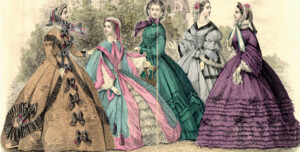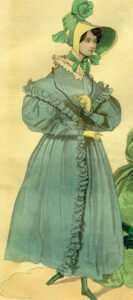 Jack H.T. Chang, M.D.
Jack H.T. Chang, M.D. Godey’s Lady’s Book fashion plates are commonly found in antique stores. Their origin began in July, 1830 when Louis Antoine Godey and Charles Alexander of Philadelphia published the inaugural issue under the title, Lady’s Book containing one fashion plate. It was not the first American magazine with women as its target audience as the Ladies Magazine started in 1828 with Sarah Josepha Hale as its editress. The Ladies Magazine was primarily a literary publication. However, Godey recognized the talents of Mrs. Hale, acquired the Ladies Magazine, and hired her as the editress of the Ladies Book in 1836. Three years later, Godey bought out his partner and henceforth the magazine became Godey’s Lady’s Book.
Prior to Mrs. Hale’s appearance, Godey’s fashion plates were copied illegally from French and English fashion magazines (Fig 1) of which there were many. In the early 19th century copyright was neither regulated nor enforced and Mr. Godey had been a “scissor’s editor,” literally cutting articles from other publications and reproducing without proper credit or remuneration. Upon Mrs. Hale’s arrival in 1837 fashion prints were then originally created for the Lady’s Book to better suit the “sensibilities of the American woman.” Mrs. Hale did far more than simply advance literature or fashion; she became the social conscious of the 19th century American woman. Her many accomplishments included the authorship of several dozen books and hundreds of poems including “Mary had a Little Lamb.” She advocated advance education of girls and women, becoming advisor to Matthew Vassar establishing the first women’s college in the United States. Mrs. Hale fought for the right of married women to retain property, better pay and working conditions, day care, and women as teachers and physicians. Her charitable efforts included the Mount Vernon Memorial, the Bunker Hill Monument, and the Sailor’s Home. She is credited with influencing President Abraham Lincoln to declare Thanksgiving as a national holiday.
 In the early years, the Lady’s Book awaited the arrival of British and French fashion magazines in order to duplicate the fashion plates. Mrs. Hale instituted foreign correspondents and moved to establish an American style of women’s dress. While still greatly influenced by French couture, the American fashions were less flamboyant and more importantly could be attained by the middle class woman using less expensive materials. With the advent of the sewing machine in the 1840s and dress patterns of the 1850s, fashionable dresses were available to the Boston elite as well as to the prairie housewife. By the 1850s, Godey’s Lady’s Book claimed a circulation of over 150,000 subscribers.
In the early years, the Lady’s Book awaited the arrival of British and French fashion magazines in order to duplicate the fashion plates. Mrs. Hale instituted foreign correspondents and moved to establish an American style of women’s dress. While still greatly influenced by French couture, the American fashions were less flamboyant and more importantly could be attained by the middle class woman using less expensive materials. With the advent of the sewing machine in the 1840s and dress patterns of the 1850s, fashionable dresses were available to the Boston elite as well as to the prairie housewife. By the 1850s, Godey’s Lady’s Book claimed a circulation of over 150,000 subscribers. Individual colored fashion plates also expanded from the initial single to five figures including children and the occasional male. In the 1860s, Godey’s Lady’s Book introduced another innovation, the fold out color fashion plate (Fig. 2). With the increase in skirt size of the early 1860s, greater space was necessary to accommodate the change in style. As the skirts reduced width in the 1870s, the number of colored fashion figures increased to a maximum of nine per plate.
Godey’s Lady’s Book also contained numerous black and white illustrations of current fashions which became quite numerous after the 1860s.
Other illustrations, both colored and black and white accompanied a variety of literary articles, embroidery patterns, architecture, interior decorating and a potpourri of practical advice for the homemaker.
The engraving methods improved from its 1830 beginnings. However, the value of Godey’s Lady’s Book fashion plates was far more dependent upon the rarity of the earlier prints rather than the quality of the engravings. Additionally, it was not unusual to find the same fashion plates with different colors. At one point, Godey had over 150 women hand coloring the fashion plates. When one color was depleted, another was substituted.
Collecting Godey and other fashion plates is quite affordable. Those fashion plates after the 1850s may be in the $20 to $40 range. In the 1840s and 1850s other women fashion magazines were established, notably Peterson, Graham’s and Harper’s, all with fashion illustrations. Godey plates of the 1830s and 40s are rare and may demand hundreds of dollars which is comparable to French and English fashion plates of the same era. Bound and separate issues of Godey’s Lady’s Book are available in antiquarian book sites and are surprisingly affordable. As a bibliophile, the author would decry the removal of such prints from an intact volume of Godey’s. On line auction sites offer quite affordable individual fashion plates, often framed. The author has yet to encounter reproductions even of the earlier plates. Unfortunately, Godey colored fashion plates are not identified as such and the largest collation of published plates number 80. The author has collected over one thousand colored and several thousand black and white images from several on-line sources and five public and private libraries. Further reading include monographs by Jo Anne Olian, Stella Blum and “Mr. Godey’s Ladies: Being a Mosaic of Fashions and Times” by Robert Kuncior.
Godey sold his magazine in 1877 and Sarah Josepha Hale retired after 40 years as its editress. Through the majority of its sixty-eight years of publication, Godey’s Lady’s Book not only influenced fashions but also advanced the status of women in American society.















Follow Us